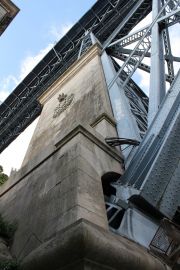Dom Luiz 1 Bridge























in Porto, Portugal
Also known as Luis I Bridge, Ponte Dom Luís I or Ponte Dom Luiz I.
A magnificent double deck wrought iron bridge over the River Douro in the centre of Porto. It has a trussed parabolic arch of 172m span. The upper deck, widened in 1931, is now reserved for trams and pedestrians. The lower deck is for light vehicles and pedestrians. Some sources state that the lower deck also serves to tie the arches, but the deck disappears into the masonry piers, so it is not obvious how the deck tension is transmitted to the arches.
Designed by Theophile Seyrig, and constructed by Soc. Willebroeck (Belgium) between 1881 and 1886[1]. Ten companies had tendered for the work, and the Seyrig/Willebroeck bid won despite being the third most expensive.[2]
The iron used in the construction was manufactured with special care, and under a rigid system of supervision. It came from various firms, among which the principal were La Society Anonyme de Couillet, Pierard freres, at Montigny-sur-Sambre, the iron works of Charleroi, and La Societe du Phenix de Chatelineau.[3]
An earlier, iron railway bridge - Maria Pia Bridge - designed by Gustave Eiffel and Théophile Seyrig, can be seen nearby. Although superficially similar, the arch is crescent shaped, and there is no lower deck. Constructional details show marked differences. In fact, although the basic principles are similar, and the bridges share a parent - Seyrig - the approach to detail design is very different. Perhaps this illustrates the extent to which the design work was undertaken by the bridge constructor's own designers rather than by the Responsible Engineer. This can be seen by comparing photos of any structural element on the two bridges.
A curious aspect of the Luiz I bridge is the effort that Willebroeck made to avoid using the trade of the 'angle smith' (angle iron smith). Angle smiths were widely employed by structural engineers and shipbuilders to skilfully bend angle, channel and T-sections and to 'joggle' the same (i.e. forming a 'dog leg' to accommodate step changes between components). Examples of their work can be seen in photo 9 on the Maria Pia Bridge entry. In contrast, the last photo on this page indicates how avoidance of 'joggling' makes it necessary to use extra pieces of plate to fill gaps.
A good account of aesthetic and structural aspects is available online[4]
See Engineering 1886/07/02 for drawings and description.
Early Photographs
See here for photographs showing the construction of the bridge, with the now-demolished Ponte Pensil (Porto) suspension bridge alongside.
See Also
Sources of Information
- ↑ [1] The Bridges of Porto - Technical Data by Manuel de Azeredo
- ↑ [2] 'Gustave Eiffel: Le Triomphe de l'ingénieur' by Frédéric Seitz
- ↑ Engineering 1886/07/02
- ↑ [3] A CRITICAL ANALYSIS OF THE DESIGN AND CONSTRUCTION OF THE LUIS I BRIDGE, PORTO: by J. J. West, Proceedings of Bridge Engineering 2 Conference 2011. April 2011, University of Bath, Bath, UK

